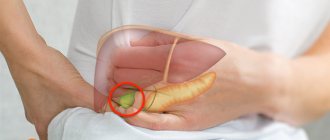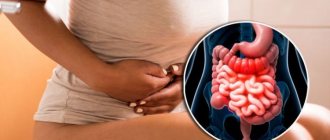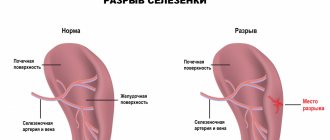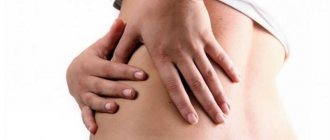Pain in the lower abdomen in women is an unpleasant sensation that often signals a harmful effect on the genital organs, their damage, or the occurrence of a condition dangerous to health. They can occur even in the absence of traumatic factors. However, discomfort affects the psycho-emotional sphere of a person’s life and limits his mobility.
According to the World Health Organization, many diseases are accompanied by this symptom. Therefore, if women experience pain in the lower abdomen, they should make an appointment with a doctor. He will correctly determine the reason for their appearance. To do this, you will undergo an examination and a comprehensive examination, which may include laboratory, visual, endoscopic and other diagnostic methods. Based on the results obtained and medical history, the doctor decides on treatment tactics - conservative and/or surgical.
Lower abdominal pain. Causes: gynecological diseases
The content of the article
Pain in the lower abdomen during menstruation
Dysmenorrhea is one of the most common pathologies that causes pain in the lower abdomen. Dysmenorrhea can be a primary cause, or secondary when diseases of the female genital organs already exist.
In severe cases of dysmenorrhea, in addition to abdominal pain, vegetative symptoms appear, such as:
- nausea;
- vomit;
- headache;
- general weakness;
- nervousness.
Endometriosis is a cause of pain in the lower abdomen
Endometriosis is a disease characterized by the appearance of the lining of the uterus outside the organ itself. The mucous membrane grows and undergoes the same changes as the uterine mucosa during the menstrual cycle.
Endometriosis
Monthly bleeding of endometriotic tissue very often causes pain in the lower abdomen. Abdominal pain usually begins a few days before the start of menstruation.
Other symptoms of endometriosis include:
- painful sexual intercourse;
- lack of pregnancy (infertility);
- dysmenorrhea.
When is help needed?
It is necessary to immediately seek professional medical help if, after the first sexual contact, the girl exhibits the following alarming symptoms:
- severe pain that does not go away for several days;
- uterine bleeding ;
- hardening of the abdomen;
- nausea and vomiting;
- feverish condition;
- purulent vaginal discharge.
Such clinical manifestations may indicate severe ruptures and other injuries that require immediate medical attention.
However, it is worth contacting a gynecologist after deflowering, even in the absence of suspicious symptoms, to make sure that non-physiological damage, infectious processes and pathologies of the uterine cervix are excluded.
Making love brings people a feeling of moral, physical satisfaction, pleasure, deep saturation, and joy.
Medicine has suggested several reasons why the weaker sex complains of malaise after intimate intimacy:
- Rupture of the hymen, in other words, the process of defloration (during first penetration).
- Muscle spasm as a result of deep, rough penetration, or too large a partner’s penis.
- Psychological discomfort. A spasm in a woman’s body, caused by panic fear of first love, can overtake her partner at the wrong time.
- Lack of orgasm. Painful sensations cause anxiety when you do not have an orgasm (blood stagnates in the pelvis).
- Inappropriate condom. If sexual intercourse is too active or rough, a condom can damage the vaginal mucosa and cause irritation of the genitals, causing pain.
- Uncomfortable position. An uncomfortable position injures the genitals and causes discomfort.
Inflammatory diseases of the pelvic organs
Pelvic inflammatory processes can be caused by numerous pathogenic microorganisms: bacteria, viruses, protozoa or fungi.
The main symptoms of inflammation of the female genital organs include:
- stomach ache;
- slight bleeding from the uterus and vagina;
- soreness of the uterus upon independent palpation of the abdomen.
When there is inflammation of the appendages on the right side, the pain that appears must be differentiated from acute inflammation of the appendix.
What is considered normal?
Why does my stomach hurt after the first sex? Most often this is due to mechanical irritation of the vaginal mucous membranes and rupture of the hymen. In addition to physiological factors, the development of pain syndrome can also be triggered by a girl’s psychological unpreparedness to enter into an intimate relationship.
Fears and stiffness contribute to overstrain of the pelvic organs, which significantly increases the risks of irritation and traumatic injuries. In this case, a lot depends on the behavior of the partner. Slow and sensual, gentle sexual contact during defloration will significantly reduce pain, both during sexual intercourse and after it.
Abdominal pain during pregnancy
An ectopic pregnancy is a pregnancy in which implantation of the embryo occurs outside the body of the uterus. The most common site of ectopic pregnancy is the fallopian (uterine) tube.
Risk factors for ectopic pregnancy include: in vitro fertilization, pelvic inflammatory disease and gynecological surgery.
To diagnose it, the level of human chorionic gonadotropin (hCG) is determined, ultrasound examination and laparoscopy are performed.
The main symptoms of an ectopic pregnancy include:
- delayed menstrual bleeding;
- irregular discharge mixed with blood from the uterus;
- severe pain in the abdominal cavity.
Types of ectopic pregnancies
Diagnostics
Establishing the root cause of pain in the lower abdomen in women is difficult even for an experienced doctor, since it is necessary to differentiate diseases of the reproductive, digestive, and urinary systems. The patient is examined by an obstetrician-gynecologist and a gastroenterologist, and other specialists are involved if necessary. The diagnostic plan includes laboratory and instrumental methods:
- Examination on the chair.
In a classic two-manual examination, the doctor assesses the size and consistency of the uterus, and identifies tenderness or enlargement of its appendages. A vaginal examination using speculum is needed to examine the mucous membrane of the vagina, cervix, and determine prolapse of the internal reproductive organs in women. - Ultrasonography.
An ultrasound scan examines the condition of the uterus and appendages, detecting signs of pregnancy, space-occupying formations, and an inflammatory process. Abdominal sonography is necessary to exclude appendicitis and pathology of the distal intestine. An ultrasound of the bladder is performed after preliminary preparation. - Endoscopic methods.
Hysteroscopy is necessary to examine the uterine cavity, find benign and malignant neoplasms, and chronic inflammation. In case of possible Crohn's disease or UC, the gastroenterologist prescribes a colonoscopy, which, if indicated, is supplemented with a biopsy. - X-ray diagnostics.
Hysterosalpingography is a method for assessing the patency of the fallopian tubes and identifying sclerotic changes in women that are specific to chronic adnexitis. To confirm or exclude pathology of the urinary organs, excretory urography is used. Irrigoscopy is used to visualize the intestinal mucosa. - Laboratory methods.
If algomenorrhea is suspected, it is necessary to determine the levels of estrogen and progesterone; for early diagnosis of pregnancy, the content of human chorionic gonadotropin is measured. If there are signs of inflammation, smears are taken from the urethra and vagina, in which the causative agent of the infection is determined using a microbiological method.
For pain in the lower abdomen, a woman should consult a gynecologist
Miscarriage
Miscarriage is the most common complication of pregnancy. This term refers to the expulsion of the fertilized egg from the uterus before 22 weeks of pregnancy. If three more miscarriages occur after the first one, this condition is called recurrent miscarriage.
The main symptoms of a miscarriage include bleeding and pain in the lower abdomen of varying severity. The most common causes are genetic, hormonal, anatomical and immunological pathologies. The risk of miscarriage is related to the age of the pregnant woman. Women who become pregnant after age 35 have a much higher risk of miscarriage.
Methods of treating pathologies
Cervical erosion
Some disorders, such as features of the hymen, cannot be treated. Psycho-emotional blockages require the patient to work with a psychotherapist and psychologist. If pain persists for a long time and a certain disease is identified, complex therapy is prescribed:
- hormonal drugs;
- surgical intervention;
- medical manipulations such as cauterization of erosion;
- antibiotics for infections.
To correct pain during the treatment of the underlying disease, antispasmodics, analgesics and anti-inflammatory non-steroidal drugs are often prescribed.
A pulling sensation in the lower abdomen after unprotected intercourse is not pregnancy in most cases. Especially if they occur on the first or second day after coitus. For a full diagnosis and identification of the exact cause of the condition, a visit to a gynecologist, tests and ultrasound are required.
Genital cancer – pain and discomfort in the lower abdomen
Malignant neoplasms of the genital organs are one of the most common tumors found in women. One of the most common types of cancer is endometrial cancer, and the most severe types with the poorest prognosis are ovarian tumors.
A woman is often not bothered by anything; signs of ovarian cancer are uncharacteristic, and their appearance begins in a late stage of development. Manifestations of ovarian cancer include: increased circumference, pain and discomfort in the lower abdomen. 20% of patients experience symptoms of diseases from the genital organs, gastrointestinal tract and bleeding from the vagina.
Other fairly rare causes of abdominal pain include:
- torsion of the uterine appendages;
- rupture of an ovarian cyst;
- acute degeneration of uterine fibroids.
These diseases are characterized by acute, sudden, very severe pain in the lower abdomen and require hospitalization and emergency medical care.
Symptoms associated with the pathological process
With pathologies of the reproductive system, pain occurs not only in the vagina and lower abdomen. It extends to the inguinal folds and lumbar region, which indicates ovarian pathology. Similar diffuse symptoms occur with internal bleeding. In this case, there may be no bleeding, but there are symptoms of anemia:
- pallor;
- fainting;
- steady decrease in pressure;
- severe dizziness.
If discomfort is associated with the appearance of blood after sexual intercourse, you should immediately make an appointment with a doctor. Other symptoms that should alert you:
- nausea;
- pain with deep penetration;
- a feeling of discomfort in the ovaries during intercourse.
The unpleasant sensations are short-term and go away on their own.
Prostate diseases
Pain in the lower abdomen in men can occur as a result of prostate disease. Prostate diseases that cause pain in the lower abdomen include:
- inflammation of the prostate gland;
- prostate hypertrophy;
- prostate cancer.
Stages of prostate cancer
Inflammation (prostatitis) in the absence of treatment becomes chronic, possible development of abscess and fistulas of the prostate gland, cystitis and pyelonephritis, infertility due to the formation of autoimmune antibodies.
Cystitis
Cystitis is a pathology in which the inflammatory process affects the walls of the bladder. The disease is several times more common in women than in men. This is due to the structural features of the female genitourinary system, including a short and wide urethra, which greatly facilitates the penetration of infections into the urinary tract.
The pathology is characterized by frequent urination, with the urge to empty the bladder appearing every 15-30 minutes. Urine has a cloudy dark color, it often contains a small amount of mucus or pus, and there may be blood inclusions.
With cystitis, the patient feels cutting pain in the pelvic area above the pubis, which sharply intensifies when trying to urinate. Warmth helps relieve pain: taking a hot shower or applying a heating pad to your stomach.
Hyperthermia signals the presence of an inflammatory process. Patients have low-grade fever. In severe cases, the infection also affects other organs of the excretory system, leading to the development of urethritis or pyelonephritis. In this case, the patient’s temperature may rise to 39-39.5°C, and the woman’s general condition sharply worsens: severe weakness, cephalalgia, nausea, lower back pain, etc. occur.
Attention!
Pyelonephritis is an inflammatory process in the tubular system of the kidneys. This condition can lead to the development of a number of complications, so it requires urgent medical intervention.
Patients with cystitis are constantly bothered by the feeling of an incompletely emptied bladder, pressure in the pelvic area, cramps and spasms. Without treatment, a woman may develop urinary incontinence.
Diagnostic measures for this pathology include clinical analysis of urine and ultrasound examination of the bladder. To accurately determine the type of infectious agent, it is also necessary to perform a bacterial culture of urine. After making a diagnosis, the specialist prescribes antibacterial drugs to the patient aimed at destroying the pathogen. Fosfomycin, Nitrofurantoin and Cephalexin are most often used in the treatment of cystitis.
. You can also use antispasmodics and folk remedies to relieve symptoms: fruit drinks, decoctions of cranberry and lingonberry leaves, etc.
Endometritis
Endometritis is a disorder in which the inflammatory process affects the inner mucous layer of the uterus. The endometrium is a functional membrane. Every month, at the end of the menstrual cycle, it is rejected and exits through the genital tract along with a small amount of blood. This layer is necessary for carrying a pregnancy in case of successful fertilization, as well as for protecting the uterus from various bacteria and viruses.
The functional layer is formed by single-layer columnar epithelium. This is a structure quite sensitive to various stimuli. Normally, damage to the endometrium does not cause an inflammatory response. The cause of the development of endometritis is various pathogens that penetrate the thickness of the uterus in the presence of damage to the mucosa.
Attention!
During menstruation, women should be especially careful during sexual activity, since during this period the endometrium and myometrium are especially susceptible to infections.
With endometritis, patients experience the following symptoms:
- hyperthermia up to 38-39°C, fever, chills;
- cutting pain in the lower abdomen;
- discharge with an unpleasant odor from the genital tract;
- increased pain when trying to urinate or have a bowel movement;
- tachycardia, sweating;
- cephalgia;
- weakness and lethargy.
Attention!
If you suspect the development of endometritis, you should urgently contact a gynecologist. Lack of timely treatment can lead to the development of a more serious disease - endomyometritis, in which the infection also affects the mucous layer of the uterus.
Therapy for this pathology includes the mandatory use of broad-spectrum antibacterial drugs. Sparfloxacin is currently the most widely used
and its analogues. Physiotherapy is also indicated for women: magnetic wave treatment, electrophoresis, ultraviolet treatment, etc.










